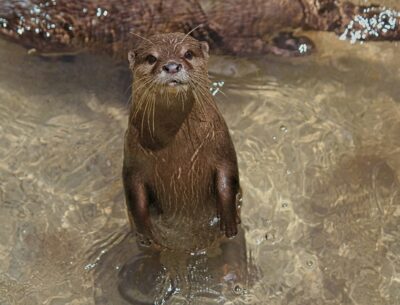
Escaped Otter Returns to Wisconsin Zoo; Companion Still at Large
One of two North American river otters that had escaped from the NEW Zoo & Adventure Park in Green Bay, Wisconsin, has been safely returned. Ophelia, the female otter, was captured on Friday night after a two-week absence. Her return was kept confidential until Tuesday to allow for a thorough veterinary examination, which confirmed her good health. However, due to her naturally shy disposition, Ophelia may not always be visible to visitors, as she tends to seek secluded spots for rest.
The escape occurred during a snowstorm, when Ophelia and her male companion, Louie, managed to enlarge a small hole in their enclosure’s fencing. While Ophelia has returned, Louie remains missing. Given that this period coincides with the otter breeding season, zoo staff believe he may have ventured farther in search of a mate. Nonetheless, as river otters are naturally territorial animals, there is optimism that he has not gone far from the vicinity.
Efforts to locate Louie are ongoing and include the help of a professional tracker, the use of motion-activated trail cameras, and outreach to local residents who may have spotted him. The zoo has emphasized that Louie poses no threat to humans and, being a native species, is well equipped to survive temporarily in the wild. River otters are adept swimmers and skilled at catching fish, giving them a strong chance of self-sufficiency until recapture.
To provide broader context, the North American river otters is a member of the weasel family and is known for its playful and lively nature. These animals thrive in clean rivers, lakes, and marshes, and their presence is often considered an indicator of a healthy aquatic ecosystem. Otters are known to slide down muddy or snowy slopes for both fun and travel, a behavior that reflects their curious and energetic temperament.
One particularly fascinating aspect of otter behavior is their use of tools—some otters have been observed using rocks to crack open shellfish. They also have webbed feet and dense fur to keep them warm and agile in cold waters. Their fur is among the thickest in the animal kingdom, helping to insulate them even in frigid temperatures, a trait that may have served Ophelia well during her time outdoors.
Otters are often active during dawn and dusk, and they maintain strong family bonds. In the wild, they live in dens, often repurposing abandoned burrows near water. Their diet consists mostly of fish, but they also eat frogs, small mammals, and crustaceans.